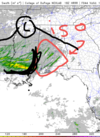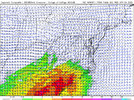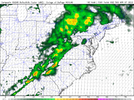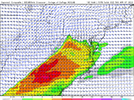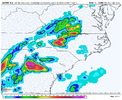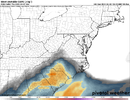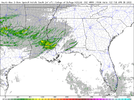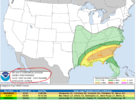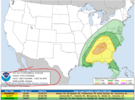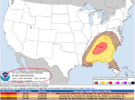Monday's outlook has been shifted a bit further NW into far southern OK, and a broad 5% tornado risk area has been added (including DFW):




SPC AC 030556
Day 2 Convective Outlook
NWS Storm Prediction Center Norman OK
1256 AM CDT Sun Apr 03 2022
Valid 041200Z - 051200Z
...THERE IS A SLIGHT RISK OF SEVERE THUNDERSTORMS FROM SOUTHERN OK
INTO CENTRAL/EASTERN TX AND THE LOWER MS VALLEY...
...SUMMARY...
A broad area of severe-thunderstorm potential will exist Monday
across central/eastern Texas, eastward into the Lower Mississippi
Valley vicinity through Monday night. Damaging wind gusts, large
hail and tornadoes will all be possible.
...OK/TX/ArkLaTex...
A somewhat broad, and neutral to positive-tilt upper trough over the
southwestern U.S. will develop eastward to the Ozarks/Sabine Valley
vicinity by Tuesday morning. As this occurs, increasing midlevel
southwesterly flow will overspread parts of central/eastern TX into
the Lower MS Valley. Additionally, a south/southwesterly low-level
jet will increase to around 40-50 kt during the evening and
overnight across eastern TX into the lower MS Valley. The evolution
of surface pattern appears somewhat messy and uncertain. A stalled
front will reside from northwest TX into central OK and the Mid-MS
Valley early in the period. Elevated thunderstorms may be ongoing
along this boundary Monday morning across OK and far north TX. This
activity should spread eastward or dissipate through the morning,
but steep midlevel lapse rates could allow for some marginal hail.
Southerly low-level flow will transport Gulf moisture northward
through the day, with 60s surface dewpoints as far north as the Red
River/far southern OK possible by afternoon. Mid to upper 60s
dewpoints may make it as far north as I-20. Coupled with steep
midlevel lapse rates, moderate destabilization is expected despite
somewhat modest diurnal heating. An EML/capping around 850-700 mb
will likely limit thunderstorm activity for much of the day across
TX. By early evening, a weak low is forecast to develop over
northwest TX and a cold front will shift east across OK/north TX to
the ArkLaTex overnight. Initial supercells are possible in the
vicinity of the surface low and southward along the cold
front/dryline composite. While storms maintain discrete mode, large
hail and damaging gusts will be possible across north/central TX.
However, it is unclear how long discrete cells may be maintained. An
increasing low-level jet and deep-layer flow parallel to the surface
boundary suggests upscale development into a QLCS is likely.
Nevertheless, favorable low-level shear will exist and support
mesovortex formation within any line that develops. Damaging gusts
and a few tornadoes appear possible across parts of north/east TX
into the ArkLaTex during the evening/nighttime hours.




SPC AC 030556
Day 2 Convective Outlook
NWS Storm Prediction Center Norman OK
1256 AM CDT Sun Apr 03 2022
Valid 041200Z - 051200Z
...THERE IS A SLIGHT RISK OF SEVERE THUNDERSTORMS FROM SOUTHERN OK
INTO CENTRAL/EASTERN TX AND THE LOWER MS VALLEY...
...SUMMARY...
A broad area of severe-thunderstorm potential will exist Monday
across central/eastern Texas, eastward into the Lower Mississippi
Valley vicinity through Monday night. Damaging wind gusts, large
hail and tornadoes will all be possible.
...OK/TX/ArkLaTex...
A somewhat broad, and neutral to positive-tilt upper trough over the
southwestern U.S. will develop eastward to the Ozarks/Sabine Valley
vicinity by Tuesday morning. As this occurs, increasing midlevel
southwesterly flow will overspread parts of central/eastern TX into
the Lower MS Valley. Additionally, a south/southwesterly low-level
jet will increase to around 40-50 kt during the evening and
overnight across eastern TX into the lower MS Valley. The evolution
of surface pattern appears somewhat messy and uncertain. A stalled
front will reside from northwest TX into central OK and the Mid-MS
Valley early in the period. Elevated thunderstorms may be ongoing
along this boundary Monday morning across OK and far north TX. This
activity should spread eastward or dissipate through the morning,
but steep midlevel lapse rates could allow for some marginal hail.
Southerly low-level flow will transport Gulf moisture northward
through the day, with 60s surface dewpoints as far north as the Red
River/far southern OK possible by afternoon. Mid to upper 60s
dewpoints may make it as far north as I-20. Coupled with steep
midlevel lapse rates, moderate destabilization is expected despite
somewhat modest diurnal heating. An EML/capping around 850-700 mb
will likely limit thunderstorm activity for much of the day across
TX. By early evening, a weak low is forecast to develop over
northwest TX and a cold front will shift east across OK/north TX to
the ArkLaTex overnight. Initial supercells are possible in the
vicinity of the surface low and southward along the cold
front/dryline composite. While storms maintain discrete mode, large
hail and damaging gusts will be possible across north/central TX.
However, it is unclear how long discrete cells may be maintained. An
increasing low-level jet and deep-layer flow parallel to the surface
boundary suggests upscale development into a QLCS is likely.
Nevertheless, favorable low-level shear will exist and support
mesovortex formation within any line that develops. Damaging gusts
and a few tornadoes appear possible across parts of north/east TX
into the ArkLaTex during the evening/nighttime hours.











